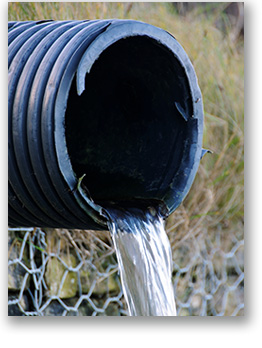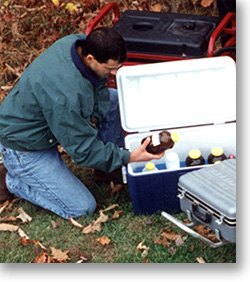 Winter • 2023 Winter • 2023 |
In this Issue: |
 |
EPA proposes changes to NPDES test procedures The Environmental Protection Agency (EPA) is proposing changes to its test procedures required to be used by industries and municipalities when analyzing the chemical, physical, and biological properties of wastewater and other samples for reporting under EPA’s National Pollutant Discharge Elimination System (NPDES) permit program. The Clean Water Act (CWA) requires EPA to promulgate these test procedures (analytical methods) for analysis of pollutants. EPA anticipates that these proposed changes would provide increased flexibility for the regulated community in meeting monitoring requirements while improving data quality. In addition, this proposed update to the CWA methods would incorporate technological advances in analytical technology and make a series of minor changes and corrections to existing approved methods. As such, EPA expects that there would be no negative economic impacts resulting from these proposed changes. Comments on this proposed rule must be received on or before April 24, 2023, published in the Federal Register February 21, 2023. Click here to view proposed rule. Source: JJ Keller Compliance Network. |
 |
EPA launches new "PFAS Analytic Tools" website The EPA unveiled new website tools, PFAS Analytic Tools, this month. Designed to help the “public, researchers, and other stakeholders better understand potential PFAS sources in their communities,” the tools provide “multiple sources of information in one spot with mapping, charting, and filtering functions,” which allows the public to see where testing has been done and what levels of detection were measured, an EPA news release states.. EPA’s PFAS Analytic Tools webpage brings together for the first-time data from multiple sources in an easy-to-use format. This webpage will help communities gain a better understanding of local PFAS sources, according to the EPA release. Multiple national databases and reports are consolidated within the PFAS Analytic Tools webpage, and it includes information about:
The tools cover a broad list of PFAS and represent the EPA’s ongoing efforts to provide the public with access to the growing amount of available testing information. The regulatory framework for PFAS chemicals is still developing. Due to the changing nature of PFAS regulations, users of the PFAS Analytic Tools are advised to “pay close attention to the caveats found within the site so that the completeness of the data sets is fully understood,” according to the Agency news release. The Agency has chosen to publish information on PFAS as it becomes available rather than waiting for the availability of complete national data. Users should be aware that some of the data sets are complete at the national level, whereas others are not. For the subset of states and tribes publishing PFAS testing results in drinking water, the percentage of public water supplies tested varied significantly from state to state. Because of the differences in testing and reporting across the country, the data should not be used for comparisons across cities, counties, or states. Source: EHS Daily Advisor |
 |
Best practices for packing sample coolers Accurate, defensible sample analysis begins with the mundane task of properly preparing and packing samples for transport to the lab. Here are 10 cooler packing tips to help you protect your samples from damage and maintain sample temperatures within the regulatory required range of 2º to 6º Celsius.
|
 |
QEC trade show schedule for 2023 QEC will be exhibiting at these conferences and expos in the remainder of 2023. If you're attending any of these events, please stop by for a visit. We would love to see you.
For more information or to schedule a specific time for a visit, please contact our Customer Service Team. |
 |
Why Was Roman Concrete So Durable? The ancient Romans were masters at construction with concrete, and their works have survived for millennia. Rome’s famed Pantheon, which has the world’s largest unreinforced concrete dome and was dedicated in AD 128, is still intact, and some ancient Roman aqueducts still deliver water to Rome today. Meanwhile, many modern concrete structures have crumbled after a few decades. Researchers have long tried to figure out the secret of this ultradurable ancient construction material, particularly in structures that endured especially harsh conditions, such as docks, sewers, and seawalls, or those constructed in seismically active locations. Now, a team of investigators from MIT, Harvard University, and laboratories in Italy and Switzerland, has made progress in this field, discovering ancient concrete-manufacturing strategies that incorporated several key self-healing functionalities. The findings are published in the journal Science Advances. For many years, researchers have assumed that the key to the ancient concrete’s durability was based on one ingredient: pozzolanic material such as volcanic ash from the area of Pozzuoli, on the Bay of Naples. This specific kind of ash was even shipped all across the vast Roman empire to be used in construction, and was described as a key ingredient for concrete in accounts by architects and historians at the time. Under closer examination, these ancient samples also contain small, distinctive, millimeter-scale bright white mineral features, which have been long recognized as a ubiquitous component of Roman concretes. These white chunks, often referred to as “lime clasts,” originate from lime, another key component of the ancient concrete mix. These are not found in modern concrete formulations, so why are they present in these ancient materials? The new study suggests that these tiny lime clasts gave the concrete a previously unrecognized self-healing capability. Historically, it had been assumed that when lime was incorporated into Roman concrete, it was first combined with water to form a highly reactive paste-like material, in a process known as slaking. But this process alone could not account for the presence of the lime clasts. Was it possible that the Romans might have actually directly used lime in its more reactive form, known as quicklime? Studying samples of ancient concrete, it was determined that the white inclusions were, indeed, made out of various forms of calcium carbonate. And spectroscopic examination provided clues that these had been formed at extreme temperatures, as would be expected from the exothermic reaction produced by using quicklime instead of, or in addition to, the slaked lime in the mixture. Hot mixing, researchers concluded, was actually the key to the super-durable nature. The benefits of hot mixing are twofold: First, when the overall concrete is heated to high temperatures, it allows chemistries that are not possible if you only used slaked lime, producing high-temperature-associated compounds that would not otherwise form. Second, this increased temperature significantly reduces curing and setting times since all the reactions are accelerated, allowing for much faster construction.” During the hot mixing process, the lime clasts develop a characteristically brittle nanoparticulate architecture, creating an easily fractured and reactive calcium source, which could provide a critical self-healing functionality. As soon as tiny cracks start to form within the concrete, they can preferentially travel through the high-surface-area lime clasts. This material can then react with water, creating a calcium-saturated solution, which can recrystallize as calcium carbonate and quickly fill the crack, or react with pozzolanic materials to further strengthen the composite material. These reactions take place spontaneously and therefore automatically heal the cracks before they spread. Previous support for this hypothesis was found through the examination of other Roman concrete samples that exhibited calcite-filled cracks. To prove that this was indeed the mechanism responsible for the durability of the Roman concrete, the team produced samples of hot-mixed concrete that incorporated both ancient and modern formulations, deliberately cracked them, and then ran water through the cracks. Sure enough: Within two weeks the cracks had completely healed, and the water could no longer flow. An identical chunk of concrete made without quicklime never healed, and the water just kept flowing through the sample. As a result of these successful tests, the team is working to commercialize this modified cement material. Source: Lab Manager News This press release was originally published on the Massachusetts Institute of Technology website |
© 2023 | Quality Environmental Containers, Inc. |
|

